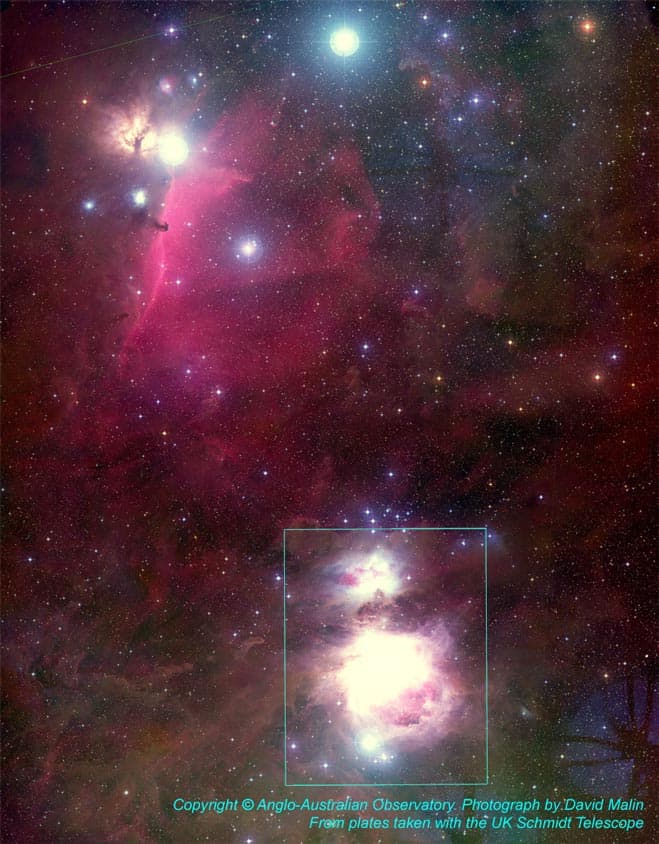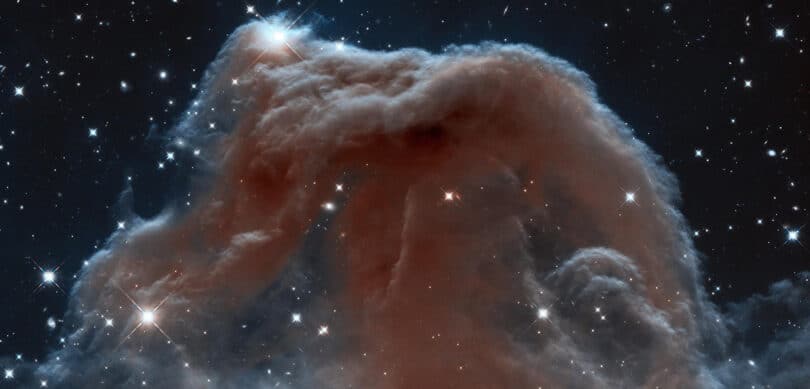Located in the vast constellation of Orion, the Horsehead Nebula is one of the most identifiable nebulae in the sky.
At a distance of approximately 1,500 light-years from Earth, this intriguing dark nebula stands out sharply against the bright backdrop of glowing gas and stars.
We understand it as a region of complex cosmic dust and gas where star formation is actively taking place, offering us vital insights into these stellar nurseries.
Our fascination with the Horsehead Nebula isn’t just due to its distinctive shape, which resembles a horse’s head when viewed from our vantage point.
It is also a focus of scientific study because it represents a type of interstellar cloud where the conditions are just right for the birth of new stars.
As we delve into the mysteries of the Horsehead Nebula, we encounter a region rich in ionized hydrogen and laced with dust that obscures visible light.
This complexity makes it an excellent laboratory for understanding the interplay between intense ultraviolet light from nearby stars and the dense materials of the nebula, providing a clearer picture of the forces shaping such interstellar environments.
Discovering the Horsehead Nebula
As we explore the fascinating history of the Horsehead Nebula, it’s important to note the key roles played by pioneering astronomers, transformative advancements in telescope technology, and the critical observations that have allowed us to understand this celestial landmark.
The Horsehead Nebula was first recognized for its unique equine shape with the help of a photograph captured at the Harvard College Observatory.
It was astronomer Williamina Fleming in 1888 who identified the nebula from a photographic plate.
This discovery marked a significant milestone in the field of astrophotography, showcasing the potential of photographs in revealing details that were not visible through direct telescope observations at the time.
Advancements in Telescope Technology
Technological advancements in telescope design and imaging have greatly enhanced our ability to observe and analyze cosmic phenomena such as the Horsehead Nebula.
As telescopes became more powerful, with improved optical and digital imaging capabilities, the detailed features of the nebula began to emerge.
These advancements allowed us to capture clearer and more detailed images of the nebula, moving from grainy black-and-white photographs to high-resolution color imagery that reveals the nebula’s intricate structures and composition.
Characteristics and Composition
The Horsehead Nebula, known within astronomical catalogs as Barnard 33 (B33), is a small but identifiable part of the vast Orion molecular cloud complex.
Its iconic silhouette, reminiscent of a horse’s head when viewed from Earth, is the result of its intricate structure which comprises mostly of dusty composition shaped by the interstellar medium.
Dusty Composition and Light Absorption
Composed primarily of dust and hydrogen gas, the Horsehead Nebula stands out as a dark nebula.
This dust and gas do not emit light on their own; rather, they are silhouetted against the brighter background of the emission nebula known as IC 434.
Light from nearby stars is absorbed by this dense cloud, making the nebula appear dark against the more luminous backdrop.
Within this dark cloud, complex processes hint at the birth of new stars, contributing to the continuous evolution of the cosmos.
The Horsehead Nebula in the Orion Complex
Nestled within the vast expanse of the Orion Molecular Cloud Complex, the Horsehead Nebula emerges as a striking dark silhouette against the tapestry of the cosmos. Our journey into this celestial landmark reveals intricate relationships and stellar births that continue to captivate astronomers and enthusiasts alike.

Spatial Relationships
The Horsehead Nebula, also known as Barnard 33, is intimately linked with several prominent celestial features within the Orion Molecular Cloud Complex.
Located just to the south of Alnitak, the easternmost star of Orion’s Belt, it forms part of the stunning scenery that comprises the Orion Complex.
This dark nebula is itself a small faction of the much larger Orion Molecular Cloud, a breeding ground for new stars situated within the constellation Orion.
Adjacent to the Horsehead Nebula, we find the Flame Nebula and, nearby, the renowned Orion Nebula, both of which are active star-forming regions.
Star Formation Within the Nebula
Within the Horsehead Nebula, we observe intricate processes of star formation, a testament to the nebula’s role in nurturing nascent stars.
The nebula’s opaque dust is shaped by powerful, sculpting forces, including the nearby bright star Sigma Orionis.
The interaction with this star’s energy contributes to the distinct appearance of the Horsehead. Moreover, the IC 434 region lying behind the Horsehead Nebula provides a luminous backdrop, a glowing canvas of ionized hydrogen gas against which the Horsehead’s features become prominently visible.
This intricate dance of dust and light reveals a cradle of star creation, where new celestial bodies are gradually taking form.
Exploration and Study
The Horsehead Nebula, situated approximately 1,500 light-years away in the constellation Orion, is a prime example of a star-forming region.
Through our telescopes, we can observe intricate structures, including ionized hydrogen gas that delineates the edges of this nebula.
The European Space Agency (ESA) has contributed significantly to our understanding with instruments like Euclid, which recently provided a detailed image of the nebula.
This impressive telescope, part of the broader Euclid Consortium, is an invaluable tool for peering into the nebula’s depths.
Our investigations reveal a complex play of magnetic fields and infrared radiation, highlighting areas where baby stars are being born within dense clumps of gas and dust.
The NGC 2023 region, adjacent to the Horsehead, fascinates us with its active star-forming properties, unveiling a dance of creation that spans vast expanses of time and space.


